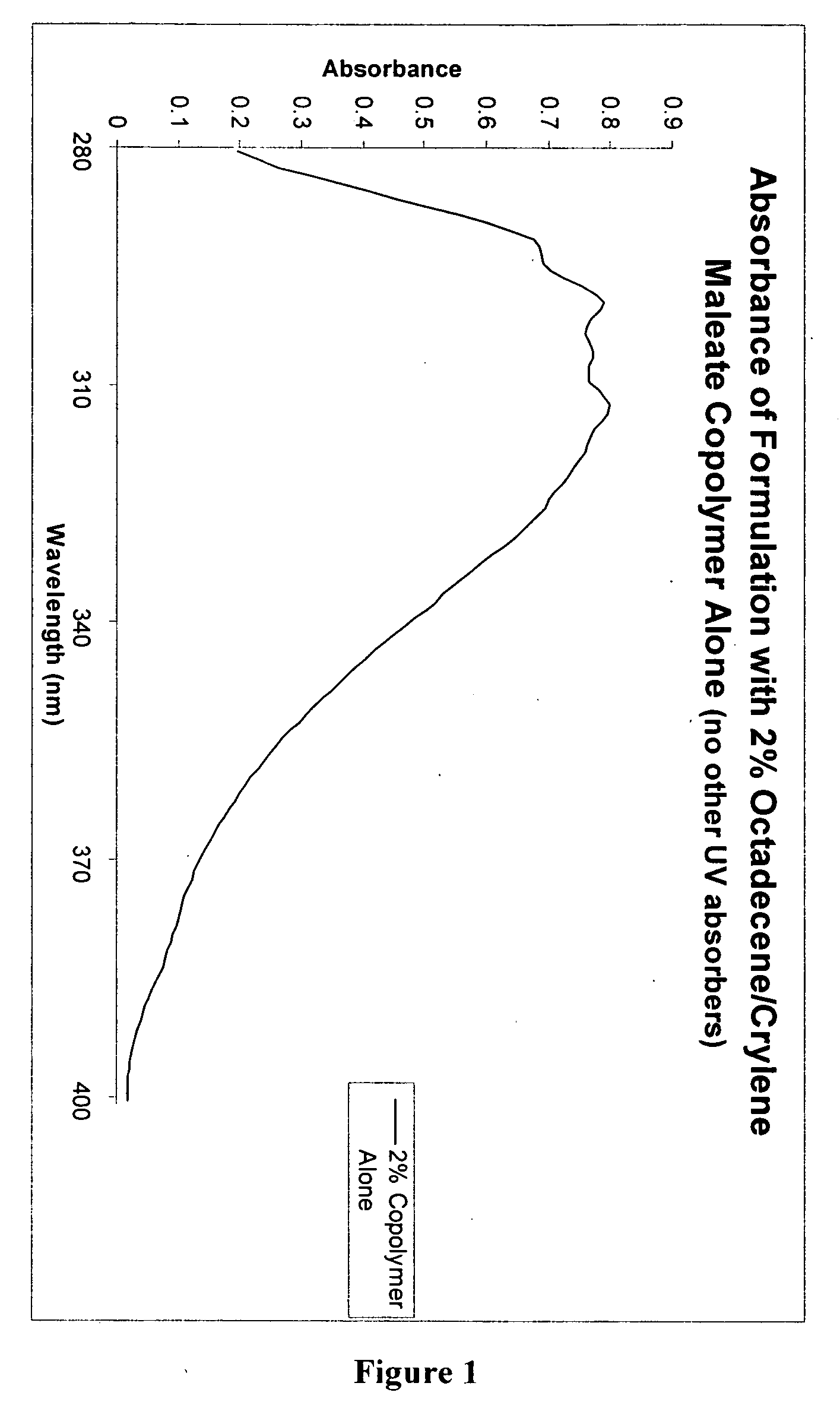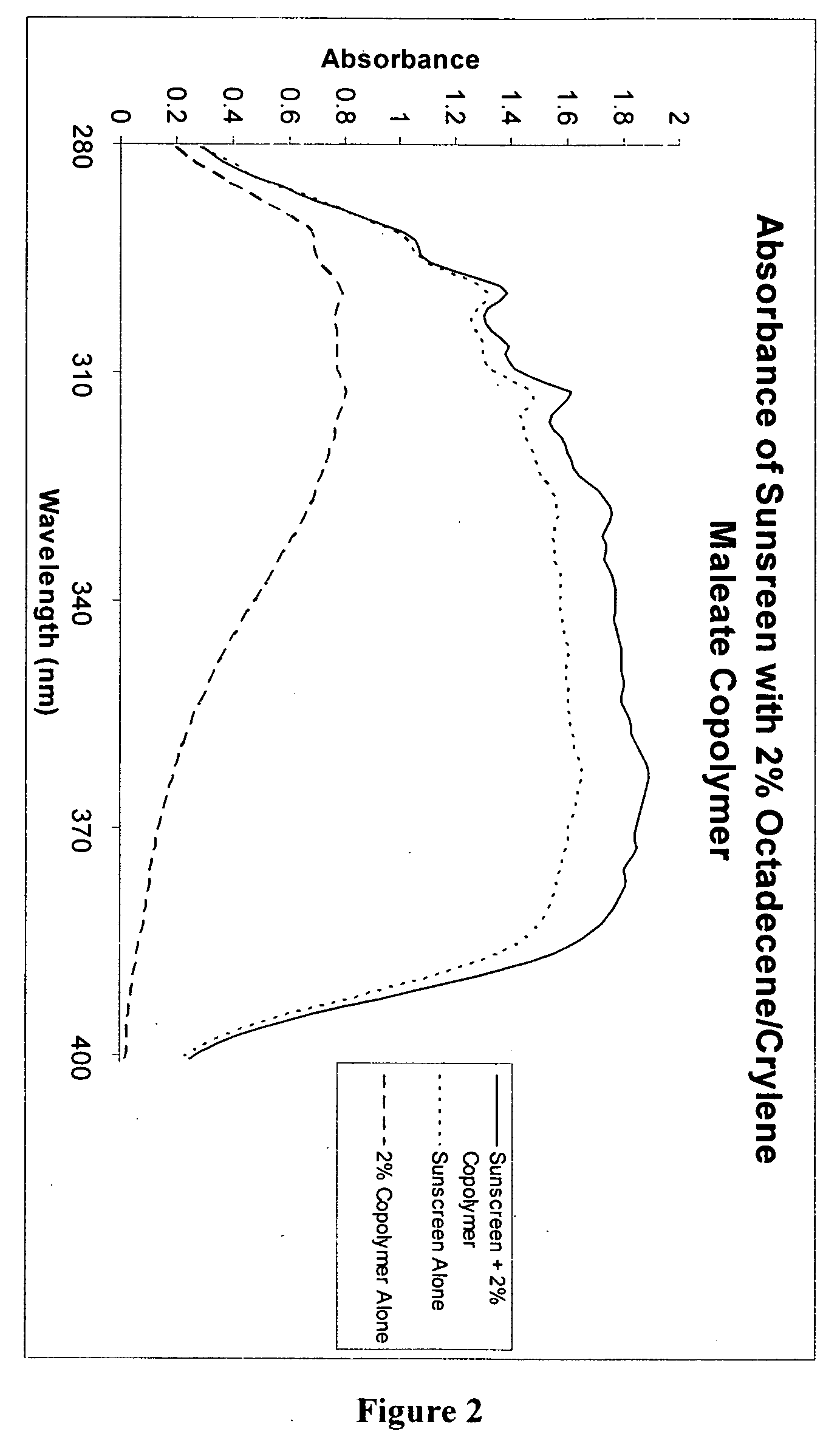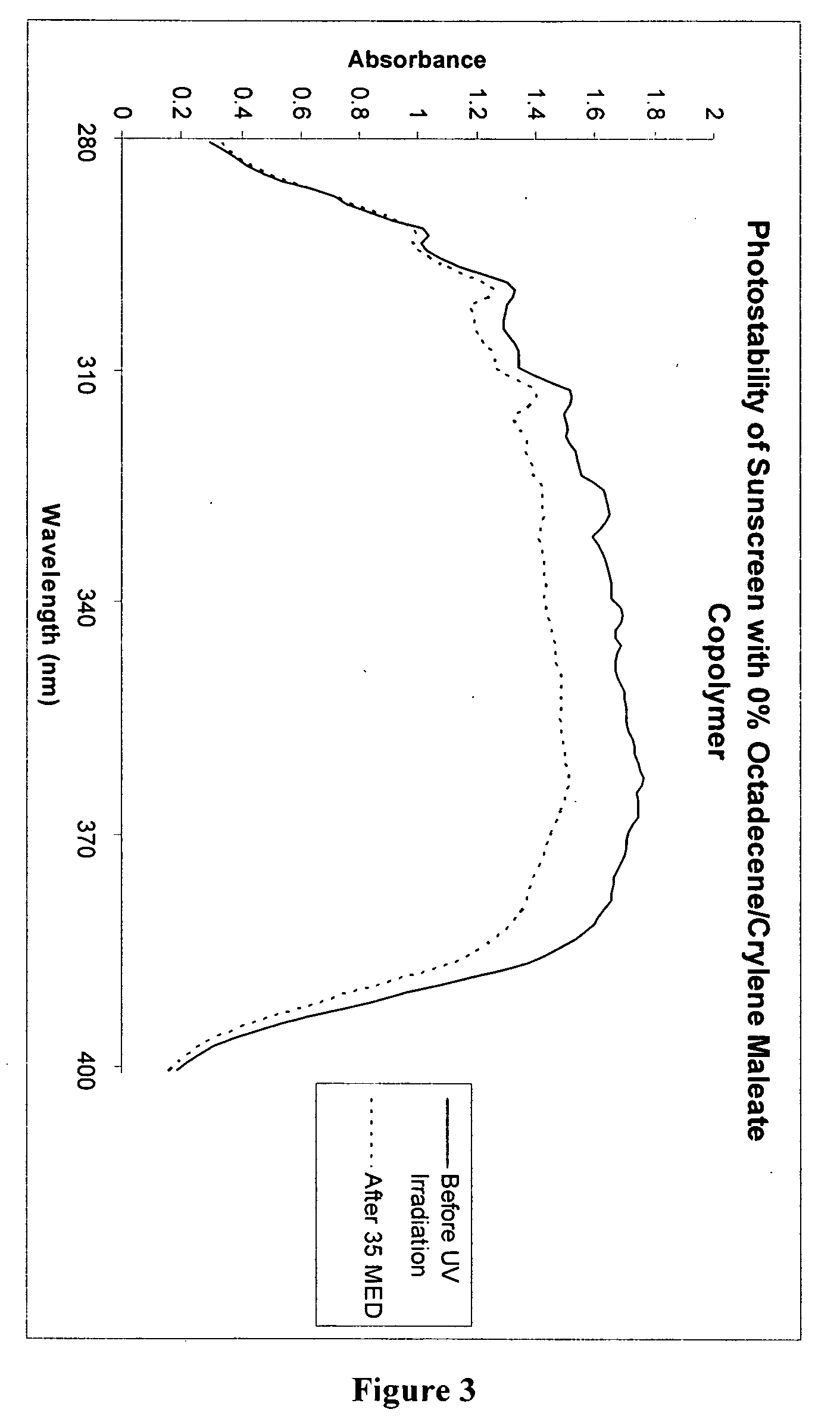Compounds derived from polyanhydride resins with film-forming, UV-absorbing, and photostablizing properties, compositions containing same, and methods of using the same
a technology of polyanhydride resin and composition, which is applied in the field of compound and methods to increase the uvabsorbance, water resistance, and photostability of a variety of compositions, can solve the problems of skin elasticity and wrinkle reduction, harm to coatings containing photoactive substances, such as photoactive pigments and dyes, and burns that are detrimental to the development of a good sun tan. to achieve the effect of reducing or eliminating
- Summary
- Abstract
- Description
- Claims
- Application Information
AI Technical Summary
Benefits of technology
Problems solved by technology
Method used
Image
Examples
example 1
[0107] The following is a preparation for a polymer compound containing crylene moieties attached to the polymer backbone, wherein Poly(octadecene-1-co-maleic anhydride) resin (PA-18 available from Chevron Chemicals Co., San Francisco, Calif.) served as a polymer starting material, and 2,2-dimethyl-3-hydroxypropyl-2-cyano-3,3-diphenylpropenoate served as the crylene moiety with a tether of neopentyl glycol. The PA-18 Polyanhydride Resin (300 g) and 2,2-dimethyl-3-hydroxypropyl-2-cyano-3,3-diphenylpropenoate (258 g) were placed in 2L 3-neck round-bottom flask and 800 ml of toluene was added. The reaction mixture was then heated and refluxed for two hours until reaction was completed (as determined by GPC). The product in solution was placed in evaporation vessels to remove the solvent. The final product was then dried and ground to give off-white powder (510 g, 91% yield).
example 2
[0108] A composition which included only the Octadecene / Crylene maleate copolymer as the only UV-Absorbing compound by mixing the ingredients shown in Table II below:
TABLE IIWeightPhaseIngredientPercentACaprylic / capric triglycerides8.00%Polyisobutene3.00%Phenylethyl benzoate1.00%Diethylhexyl malate2.00%BOctadecene / Crylene maleate copolymer2.00%CStearyl alcohol1.00%Steareth-210.22%Steareth-20.28%Polyglyceryl-3 methyl glucose distearate3.00%DDimethicone (100 cSt)0.40%EWater72.56%Disodium EDTA0.05%Carbomer0.20%FSorbitol (70%)4.29%Phenoxyethanol, Methylparaben, Ethylparaben,1.00%Propylparaben, and IsobutylparabenTriethanolamine1.00%
[0109] An oil-in-water emulsion was created, wherein the aqueous phase included a mixture of the ingredients in Phase E, and the oil phase included a mixture of the ingredients of Phases A, B, C, and D. The emulsion was prepared by combining the ingredients of Phase A, and adding this mixture of ingredients to a vessel, and heating the vessel to about 90° C...
example 3
[0111] Two sunscreen compositions were prepared by mixing the ingredients shown in Table III below:
TABLE IIISunscreenw / 0%PolymerSunscreen w / 2%PhaseIngredient(wt. %)Polymer (wt. %)AOctyl salicylate5.00%5.00%Homosalate7.50%7.50%Diethylhexyl 2,6-naphthalate2.50%2.50%Octocrylene2.50%2.50%Dimethyl capramide1.00%1.00%Diethylhexyl malate2.01%2.01%BAvobenzone3.00%3.00%Benzophenone-30.49%0.49%COctyldodecanol2.00%Octadecene / Crylene maleate2.00%copolymerDStearyl alcohol1.00%1.00%Steareth 210.29%0.29%Steareth 20.21%0.21%Polyglyceryl-3 methyl glucose3.00%3.00%distearateEWater64.16% 63.16% Disodium EDTA0.05%0.05%Carbomer0.20%0.20%Sorbitol (70%)4.29%4.29%Phenoxyethanol, Methylparaben,0.60%0.60%Ethylparaben, Propylparaben, andIsobutylparabenFTriethanolamine 0.2% 1.2%
[0112] Oil-in-water emulsions were created, wherein the aqueous phase included a mixture of the ingredients in Phase E, and the oil phase included a mixture of the ingredients of Phases A, B, C, and D. The emulsions were prepared by c...
PUM
| Property | Measurement | Unit |
|---|---|---|
| Fraction | aaaaa | aaaaa |
| Percent by mass | aaaaa | aaaaa |
| Weight | aaaaa | aaaaa |
Abstract
Description
Claims
Application Information
 Login to View More
Login to View More - R&D
- Intellectual Property
- Life Sciences
- Materials
- Tech Scout
- Unparalleled Data Quality
- Higher Quality Content
- 60% Fewer Hallucinations
Browse by: Latest US Patents, China's latest patents, Technical Efficacy Thesaurus, Application Domain, Technology Topic, Popular Technical Reports.
© 2025 PatSnap. All rights reserved.Legal|Privacy policy|Modern Slavery Act Transparency Statement|Sitemap|About US| Contact US: help@patsnap.com



